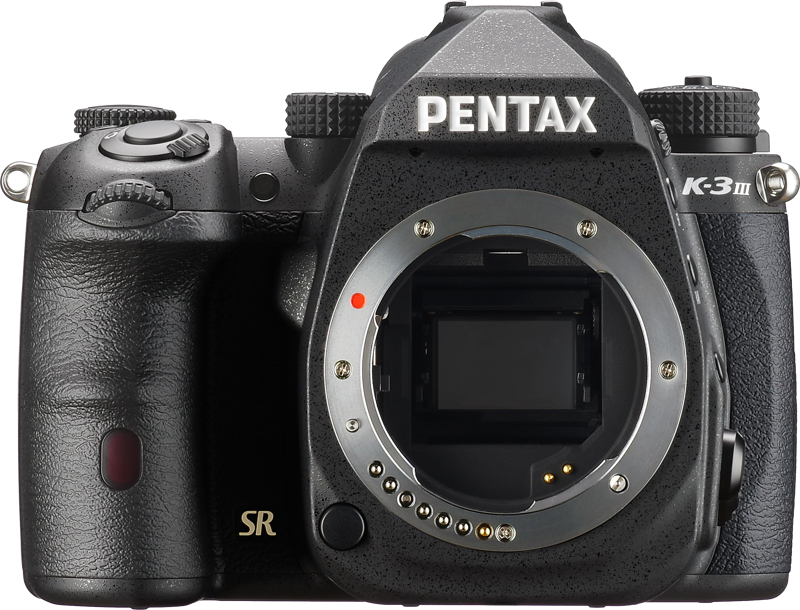

Ricoh-Pentax K-3 III
Kameror
Prisjämförelse
Produktinformation
Lägsta pris på denna produkt är 23 989 kr.
Svart kamerahus.The PENTAX K-3 Mark III in detailLarge and bright prism viewfinder with 100% field of view and approx. 1.05x magnificationThe PENTAX K-3 Mark III has an optical viewfinder with an almost 100% field of view and 1.05x magnification. The high-refractive-index glass prism allows for a wide eye relief while providing a wide field of view equivalent to that of a 35mm full-frame SLR.By using a distortion-correcting optical element and optimising the lens coatings, the viewfinder delivers a clear and lifelike image without distortion. The brightness has been improved by almost 10 percent compared to the viewfinder of the PENTAX K-3 II.The Natural Bright Matte III offers easy manual focusing and supports the benefits of using the viewfinder to frame a subject, with faithful reproduction of the bokeh effect in the image.In addition, the transparent display of a wide range of operating data in the viewfinder window allows for direct monitoring of important parameters during shooting. This underlines the importance of this essential camera component for image composition. With the large prism viewfinder of the PENTAX K-3 Mark III, the photographer has everything in view without having to take the camera away from the eye at the crucial moment.New 25.73 megapixel BSI sensor with peak light sensitivity of ISO 1,600,000The PENTAX K-3 Mark III features a BSI sensor for the first time. This back-illuminated sensor, with an effective resolution of approx. 25.73 megapixels, in combination with the new PRIME V Imaging Engine and the newly designed accelerator unit, ensures exceptionally high image quality. By additionally dispensing with an optical AA filter (anti-aliasing), the camera produces super-high resolution and sharp images.Due to the design, not only is the dynamic range extended, but noise is also minimised, even in the low or super-high range. By significantly improving noise reduction, the PENTAX K-3 Mark III offers a super-high peak light sensitivity of ISO 1,600,000.Body-integrated Shake Reduction II System (IBIS)When PENTAX first installed an electromagnetic Shake Reduction System to prevent camera shake in SLR cameras 15 years ago in the K100, this technology was not initially taken very seriously and was widely underestimated. Today, however, In Body Image Stabilizing (IBIS) systems are state of the art and should not be missing from any modern high-performance camera. In the PENTAX K-3 Mark III the Shake Reduction System fulfils a number of different functions.Camera shake compensation with compensation of 5.5 f-stopsThe built-in Shake Reduction System prevents camera shake that can occur, for example, when using lenses with a long focal length and / or slow shutter speeds in low light conditions which can be the cause of blurred images.Image stabilisation takes place in five axes. In addition to sensor rotation, horizontal and vertical shift, the PENTAX K-3 Mark III also offers horizontal and vertical tilt correction, which can occur, for example, during macro photography. Horizontal pan movements are automatically detected and corrected accordingly.All in all, this system ensures exposure reliability of up to 5.5 LV steps and thus expands the limits of freehand photography.It works independently of the lenses used. This means that adapted M42 lenses can be used in exactly the same way as the current lens series. Once stored, the lens information required for compensation can be retrieved as needed.Pixel Shift function to increase resolutionWith the previous model, the PENTAX K-3 Mark II, sensor shift was used for the first time to improve image resolution. This technique can now be used without a tripod with the PENTAX K-3 Mark III.With conventional systems, missing RGB colour information of the sensor has to be interpolated, as the different colours are not captured by all pixels of the sensor. With the Pixel Shift function, the PENTAX K-3 Mark III offers the possibility of taking four shots in a row. The sensor is shifted up, down, left and right by one pixel at a time and the camera calculates a single image from this, which can be saved as a JPEG or RAW file.With this technique, the 25.73 megapixels are fully utilised for the image file, resulting in significantly higher sharpness and colour rendition as well as lower image noise.Low-pass filter simulationBy omitting an AA filter (Anti-Aliasing), a higher image sharpness is achieved.To avoid a possible moiré effect, the sensor unit is set into micro-vibrations and thus ensures minimal blurring. This works just as effectively as a built-in low-pass filter. Two levels provide adjustment to the appropriate shooting situation.Sensor shift and auto horizon correctionThe IBIS is also used for automatic horizon alignment. An oblique camera position up to an angle of view of 2° can be corrected automatically by the sensor.However, the sensor can also be shifted manually. This can be done horizontally or vertically with a total shift of up to
Kategorier
 Avsett för vuxna
Avsett för vuxna
 Bebis och småbarn
Bebis och småbarn
 Djur och tillbehör till husdjur
Djur och tillbehör till husdjur
 Elektronik
Elektronik
 Fordon och delar
Fordon och delar
 Företag och industri
Företag och industri
 Hem och trädgård
Hem och trädgård
 Kameror och optik
Kameror och optik
 Kläder och accessoarer
Kläder och accessoarer
 Konst och underhållning
Konst och underhållning
 Kontorsmaterial
Kontorsmaterial
 Leksaker och spel
Leksaker och spel
 Mat, dryck och tobak
Mat, dryck och tobak
 Media
Media
 Metallprodukter
Metallprodukter
 Möbler
Möbler
 Programvara
Programvara
 Religion och ceremonier
Religion och ceremonier
 Resväskor och väskor
Resväskor och väskor
 Skönhet och hälsa
Skönhet och hälsa
 Sportartiklar
Sportartiklar